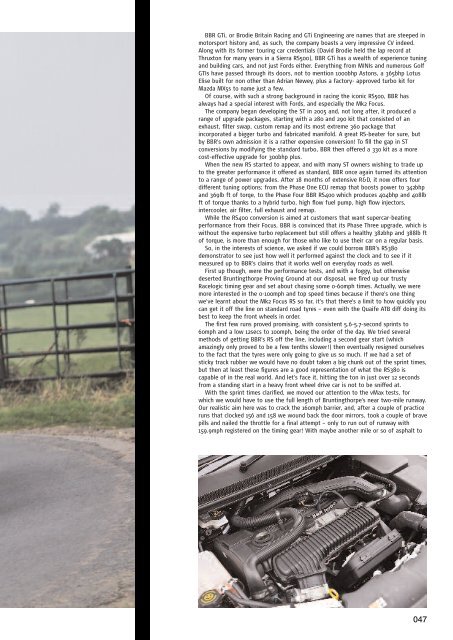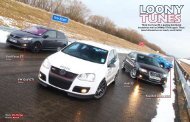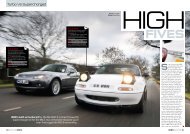LESS IS MOREGO - BBR GTi.
LESS IS MOREGO - BBR GTi.
LESS IS MOREGO - BBR GTi.
Create successful ePaper yourself
Turn your PDF publications into a flip-book with our unique Google optimized e-Paper software.
<strong>BBR</strong> <strong>GTi</strong>, or Brodie Britain Racing and <strong>GTi</strong> Engineering are names that are steeped in<br />
motorsport history and, as such, the company boasts a very impressive CV indeed.<br />
Along with its former touring car credentials (David Brodie held the lap record at<br />
Thruxton for many years in a Sierra RS500), <strong>BBR</strong> <strong>GTi</strong> has a wealth of experience tuning<br />
and building cars, and not just Fords either. Everything from MINIs and numerous Golf<br />
GTIs have passed through its doors, not to mention 1000bhp Astons, a 365bhp Lotus<br />
Elise built for non other than Adrian Newey, plus a factory- approved turbo kit for<br />
Mazda MX5s to name just a few.<br />
Of course, with such a strong background in racing the iconic RS500, <strong>BBR</strong> has<br />
always had a special interest with Fords, and especially the Mk2 Focus.<br />
The company began developing the ST in 2005 and, not long after, it produced a<br />
range of upgrade packages, starting with a 280 and 290 kit that consisted of an<br />
exhaust, filter swap, custom remap and its most extreme 360 package that<br />
incorporated a bigger turbo and fabricated manifold. A great RS-beater for sure, but<br />
by <strong>BBR</strong>’s own admission it is a rather expensive conversion! To fill the gap in ST<br />
conversions by modifying the standard turbo, <strong>BBR</strong> then offered a 330 kit as a more<br />
cost-effective upgrade for 300bhp plus.<br />
When the new RS started to appear, and with many ST owners wishing to trade up<br />
to the greater performance it offered as standard, <strong>BBR</strong> once again turned its attention<br />
to a range of power upgrades. After 18 months of extensive R&D, it now offers four<br />
different tuning options; from the Phase One ECU remap that boosts power to 342bhp<br />
and 369lb ft of torqe, to the Phase Four <strong>BBR</strong> RS400 which produces 404bhp and 408lb<br />
ft of torque thanks to a hybrid turbo, high flow fuel pump, high flow injectors,<br />
intercooler, air filter, full exhaust and remap.<br />
While the RS400 conversion is aimed at customers that want supercar-beating<br />
performance from their Focus, <strong>BBR</strong> is convinced that its Phase Three upgrade, which is<br />
without the expensive turbo replacement but still offers a healthy 382bhp and 388lb ft<br />
of torque, is more than enough for those who like to use their car on a regular basis.<br />
So, in the interests of science, we asked if we could borrow <strong>BBR</strong>’s RS380<br />
demonstrator to see just how well it performed against the clock and to see if it<br />
measured up to <strong>BBR</strong>’s claims that it works well on everyday roads as well.<br />
First up though, were the performance tests, and with a foggy, but otherwise<br />
deserted Bruntingthorpe Proving Ground at our disposal, we fired up our trusty<br />
Racelogic timing gear and set about chasing some 0-60mph times. Actually, we were<br />
more interested in the 0-100mph and top speed times because if there’s one thing<br />
we’ve learnt about the Mk2 Focus RS so far, it’s that there’s a limit to how quickly you<br />
can get it off the line on standard road tyres – even with the Quaife ATB diff doing its<br />
best to keep the front wheels in order.<br />
The first few runs proved promising, with consistent 5.6-5.7-second sprints to<br />
60mph and a low 12secs to 100mph, being the order of the day. We tried several<br />
methods of getting <strong>BBR</strong>’s RS off the line, including a second gear start (which<br />
amazingly only proved to be a few tenths slower!) then eventually resigned ourselves<br />
to the fact that the tyres were only going to give us so much. If we had a set of<br />
sticky track rubber we would have no doubt taken a big chunk out of the sprint times,<br />
but then at least these figures are a good representation of what the RS380 is<br />
capable of in the real world. And let’s face it, hitting the ton in just over 12 seconds<br />
from a standing start in a heavy front wheel drive car is not to be sniffed at.<br />
With the sprint times clarified, we moved our attention to the vMax tests, for<br />
which we would have to use the full length of Bruntingthorpe’s near two-mile runway.<br />
Our realistic aim here was to crack the 160mph barrier, and, after a couple of practice<br />
runs that clocked 156 and 158 we wound back the door mirrors, took a couple of brave<br />
pills and nailed the throttle for a final attempt – only to run out of runway with<br />
159.9mph registered on the timing gear! With maybe another mile or so of asphalt to<br />
047




